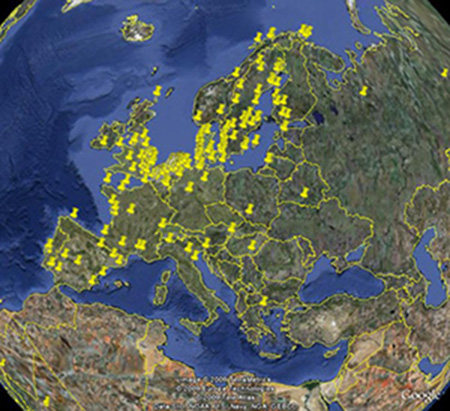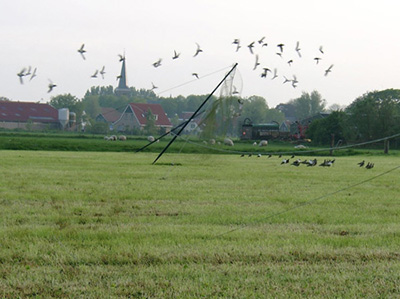Ruffs and golden plovers

Research backgrounds
Different wader species like lapwings, golden plovers, bar-tailed godwits and ruffs use the Dutch agricultural landscape during the winter or migration to/from the breeding grounds. However, many species are under pressure and to understand the ecological factors that play a role, basic research is needed. In the past 50 years, scientists have set up a close working relationship with voluntary fowler that still practice the ancient craft "wilsterflappen", a traditional way of catching waders with a big clap net and decoy birds. Together they have built a program to gain insight into the demographic developments by catching/ringing and retrapping/observing birds. In 2004, the University of Groningen started a long-term study on habitat selection, stop over duration, survival and genetic diversity of ruffs in SW Friesland. Brooding ruffs are considered as virtually extinct in the Netherlands nowadays. In less than a human generation, this spectacular species disappeared from our country because they are not able to adapt to the rapid change of the landscape through modern agricultural practices. What remained were the thousands of ruffs that stage on their way to and from northerly and easterly situated breeding areas. Southwest Friesland is one of the main staging areas in Western Europe. It is unclear where these migratory ruffs exactly breed and which part of the global breeding population passes through the Netherlands.
The numbers of migratory ruffs have declined significantly in recent years and we would like to know more about the causes. In 2010, we have started a comparative study between this species and golden plovers. Unlike ruffs, numbers of golden plovers are still considered unaffected. Both species have an overlapping breeding range and use the same grasslands during the pre-breeding stopover in the Netherlands but differ in wintering area. To understand the differences in population trends, we will need to know more of the habitat quality of the areas they encounter throughout their annual cycle. Within this project, several lines of research can be distinguished that overlap each other to a greater or lesser extent:- Survival Analysis - Calculating the annual survival of ruff and golden plover populations in South-west Friesland in order to obtain population trends. What has happened to the massive numbers of ruffs that used to pass through the Netherlands: did they die or have they shifted to other areas in Europe? We can find out by means of survival analyses based on the observations of several thousands of color ringed birds. The demographics of golden plovers can be analyzed on the basis of catches of thousands of ringed birds between 1949 and now.
- Identification of the drivers of the population dynamics - For this, we need a better understanding of the environmental factors that affect survival, both in the breeding, staging and wintering areas. You can think of knowledge about seasonal selection pressure, habitat choice, refueling capacity, age- and sex-specific behavior or variation in migration patterns.
The Netherlands play a key role as staging and wintering area for several wader species. This long-term nature study is unique in its kind in the Netherlands, and contributes to knowledge in the context of species and habitat protection.
Research setup
In this study, we cooperate closely with the Frisian “wilsternetters”. These are fowler that using a clapnet, sound and (stuffed) decoys to capture various species of waders. This artisanal method to capture birds was used previously to make some extra money but today only for scientific research.

Besides “wilsters” (Frisian for golden plover) a lot of ruffs are caught as well. These are ringed, weighed and measured by the wilsternetter, and he gives us a call so that we can pass by to give each captured ruff a unique combination of color rings. In the meantime (maximum 45 minutes) the birds are kept in a dark, well-ventilated crate in which they can move freely to reduce stress. The researchers take additional biometric data, a blood and feather sample of each bird. The unique combination of color rings allows us to recognize each individual bird in the field without recapture. We know so much more now about the wintering grounds, the main stopover places and the nesting areas of Ruffs that migrate through the Netherlands. Because we see them so often we can also better calculate how old they get, whether that changes and what this means for the population size.
Publications
- Newsletter 2004: Ruff research
- Newsletter 2009: Ruff research
- Earth Science April 24 2014: In the world of ruffs, a male bird that's sneaky ... and well endowed
Contact
To report birds with color rings:
Jos Hooijmeijer
PO Box 11103
9700 CC Groningen
Phone: +31-620136604
Other persons involved in this study are:
Theunis Piersma
Jeroen Onrust
Past PhD students:
Lucie Schmaltz
| Last modified: | 17 May 2024 3.45 p.m. |
